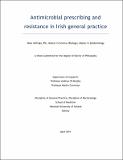| dc.description.abstract | The emerging problem of antimicrobial resistance in bacterial pathogens is complex and the result of individual and population factors. Antimicrobial agents are unique therapeutics in that their impact goes beyond the individual; antimicrobials also affect the microbial population of the host (including the pathogen population) and thereby society. The practical application of quantifying direct, individual level antimicrobial effects is to assess the short-term risk of infection with a resistant organism to an individual about to initiate antimicrobial treatment. The long-term population effect, also known as the collateral effect, involves a chain of low probability events which result in a population risk of an infection with a resistant organism which affects the individual in turn.
Standard statistical analytic approaches make the assumption that outcomes in different subjects are independent, but for antimicrobial prescribing and resistance this assumption of independence is violated as the group level prevalence of antimicrobial resistance is likely to affect the individual's risk. For this reason, studies into antimicrobial resistance need to combine information from individual and group level antimicrobial use and resistance and analyse intra as well as inter level variation.
Urinary tract infections (UTIs) are common infections and treatment of UTI in daily practice is largely empirically based. The easy availability of urine samples from patients with a suspected UTI, the established empiric treatment with antimicrobials, standard methods for diagnosis, and high antimicrobial use, make urinary tract infections an ideal subject to study antimicrobial resistance in the community.
The thesis is set up in two distinct parts, each divided into chapters representing discrete research areas (published/submitted papers) within each part. The first part used retrospective data to address the multilevel structure in the analysis of antimicrobial resistance of uropathogenic E.coli in the individual and prescribing at the general practice level. Data on practice antimicrobial prescribing were obtained from the prescriptions of medical card patients (patients with free medical care and free medication) and aggregated at the practice level. Data on antimicrobial resistance of uropathogenic E.coli from individuals were obtained from the laboratory and consisted of more than 14,000 positive urine culture results from general practices in the West of Ireland. The results from this analysis confirmed a significant association between practice level prescribing and individual risk of a resistant E.coli for trimethoprim and ciprofloxacin. The odds ratio for trimethoprim was 1.02 (95% CI 1.01-1.04) and for ciprofloxacin 1.08 (95% CI 1.04-1.11) for every additional prescription of trimethoprim or ciprofloxacin respectively per 1000 patients per month. Additionally, a theoretical risk for the practice was quantified as a median odds ratio (mOR); 1.10 (95% Credible Interval (CrI) 1.03-1.16) for trimethoprim and 1.37 (95% CrI 1.22-2.59) for ciprofloxacin. The mOR can be interpreted as the increase in risk of being diagnosed with a resistant E.coli in the imaginary event of a patient moving from a practice with low to a practice with high resistance.
Another detailed retrospective analysis which studied patients with repeated urinary tract infection, of whom only details on the resistance pattern of the E.coli were available, showed the persistence of resistance against trimethoprim as well as ciprofloxacin in repeated E.coli UTIs. The probability that an E.coli isolated from urine from a patient was still resistant up to three months after the previous isolate was found to be resistant, was 78% for trimethoprim and 84% for ciprofloxacin. For nitrofurantoin, the probability that a subsequent E.coli infection was resistant after resistance against this antimicrobial was detected in the E.coli from a previous infection, was 20%. Knowing the antimicrobial test results from previous episodes of UTI may help general practitioners in their choice of empiric antimicrobial treatment for the current episode.
The second part of the study was a prospective study in which 22 practices co-operated. All patients with a suspected UTI were requested to submit a urine sample. Patients were informed of the study and included in the study by means of an opt-out methodology. Participation of 86% was achieved. Patient data were obtained from the practice records and merged with the (antimicrobial susceptibility) results from their urine sample.
The analysis from this study resulted in two papers. Firstly, management of UTI in general practice showed important differences between practices. Overall, of the 866 patients, an organism was identified in the urine sample of 21%, while 56% received an antimicrobial. Comparing the laboratory report on the urine sample with the treatment received, treatment was interpreted as appropriate for 55% of the patients. National guidelines on antimicrobial prescribing were not always implemented, which raises concern when general practices showed preferences for antimicrobials which should be used prudently. In the second paper analysis of previous individual antimicrobial prescribing and practice resistance levels showed both have an important impact on the risk of a UTI with a resistant E.coli. The odds of a trimethoprim resistant E.coli UTI increased by 1.4 (95% CI 0.8-2.2) for one, 4.7 (95% CI 1.9-12.4) for two and 6.4 (95% CI 2.0-25.4) for three or more prescriptions of trimethoprim in the previous year, and for ciprofloxacin resistance by 2.7 (95% CI 1.2-5.6) for one and 6.5 (95% CI 2.9-14.8) for two or more prescriptions of ciprofloxacin in the previous year. Similar to the retrospective study, a mOR was calculated as 1.17 (95% CrI 1.03-1.46) for trimethoprim and 1.33 (95% CrI 1.03-1.9) for ciprofloxacin.
The thesis' discussion links the papers together, resulting in some practical suggestions for setting up interventions to curtail antimicrobial resistance. | en |


